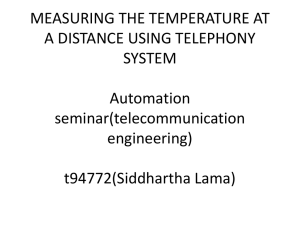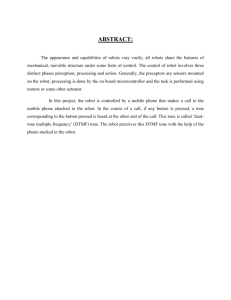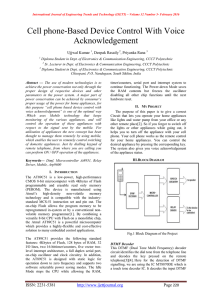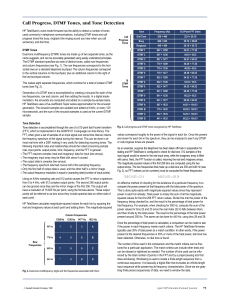P. A. Kulkarni S. G. Karad Robotics And Remotely Operated Vehicles
advertisement
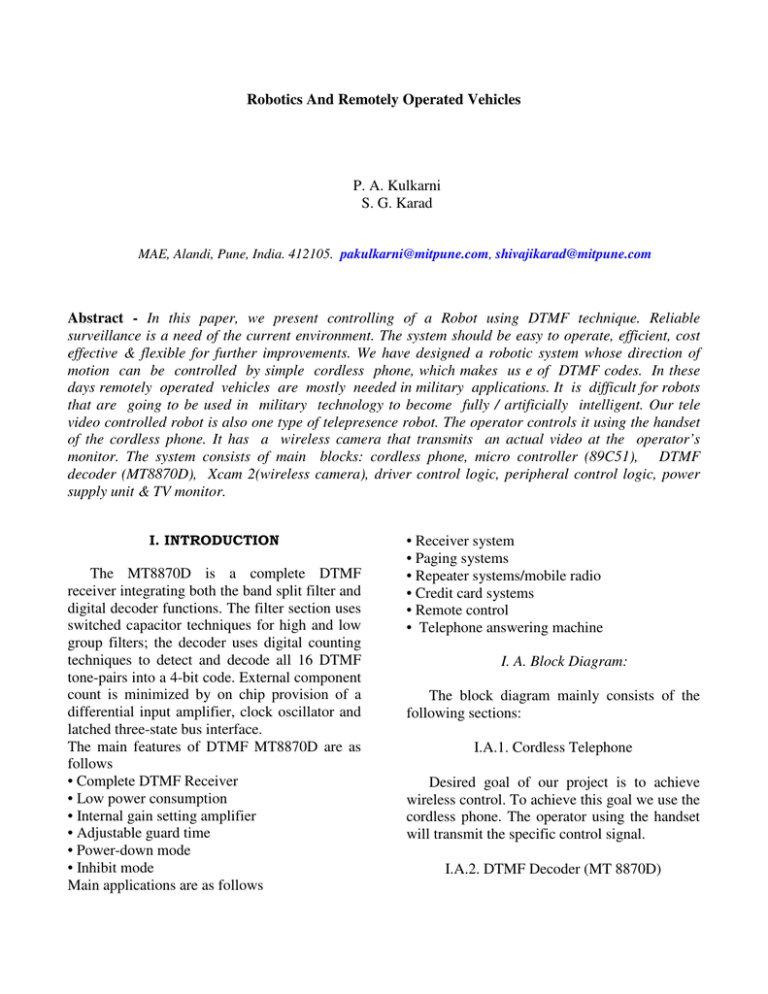
Robotics And Remotely Operated Vehicles P. A. Kulkarni S. G. Karad MAE, Alandi, Pune, India. 412105. pakulkarni@mitpune.com, shivajikarad@mitpune.com Abstract - In this paper, we present controlling of a Robot using DTMF technique. Reliable surveillance is a need of the current environment. The system should be easy to operate, efficient, cost effective & flexible for further improvements. We have designed a robotic system whose direction of motion can be controlled by simple cordless phone, which makes us e of DTMF codes. In these days remotely operated vehicles are mostly needed in military applications. It is difficult for robots that are going to be used in military technology to become fully / artificially intelligent. Our tele video controlled robot is also one type of telepresence robot. The operator controls it using the handset of the cordless phone. It has a wireless camera that transmits an actual video at the operator’s monitor. The system consists of main blocks: cordless phone, micro controller (89C51), DTMF decoder (MT8870D), Xcam 2(wireless camera), driver control logic, peripheral control logic, power supply unit & TV monitor. The MT8870D is a complete DTMF receiver integrating both the band split filter and digital decoder functions. The filter section uses switched capacitor techniques for high and low group filters; the decoder uses digital counting techniques to detect and decode all 16 DTMF tone-pairs into a 4-bit code. External component count is minimized by on chip provision of a differential input amplifier, clock oscillator and latched three-state bus interface. The main features of DTMF MT8870D are as follows • Complete DTMF Receiver • Low power consumption • Internal gain setting amplifier • Adjustable guard time • Power-down mode • Inhibit mode Main applications are as follows • Receiver system • Paging systems • Repeater systems/mobile radio • Credit card systems • Remote control • Telephone answering machine I. A. Block Diagram: The block diagram mainly consists of the following sections: I.A.1. Cordless Telephone Desired goal of our project is to achieve wireless control. To achieve this goal we use the cordless phone. The operator using the handset will transmit the specific control signal. I.A.2. DTMF Decoder (MT 8870D) The MT8870D is a complete DTMF receiver consisting of digital decoder. The decoder uses digital counting techniques to detect and decode all 16 DTMF tone-pairs into a 4-bit code. The output 4-bit code is given as input to the microcontroller. I.A.3. Microcontroller (ATM89C51) Microcontroller is the heart of the robot. Microcontroller is the main controlling unit of the robot. We are using microcontroller At89C51. The At89C51 is a low-power, highperformance CMOS 8-bit microcomputer with 4K bytes of Flash programmable and erasable read only memory (PEROM). I.A.4. Drive Control Logic And Peripheral Control Logic Drive control logic consists of relay boards. DC motors are connected to these relay boards. A relay is an on/off switch that you can control electronically. I. A.5. Wireless Camera We are using Wireless camera Xcam2 in our project. It consists of a Built-in 2.4 GHz Video Sender. I. B. Experimental The main controlling technique using DTMF can be explained as follow: Integrated DTMF Receiver I. B. 1. Features: It has low power consumption, adjustable guard time, inhibit mode. These are the features, which we have used. I. B. 2. Applications : It is widely used in Receiver system for British Telecom, Paging systems, Repeater systems/mobile radio, Credit card systems, Remote control, Personal computers, Telephone answering machine, etc. The MT8870D/MT8870D-1 is a complete DTMF receiver integrating both the band split filter and digital decoder functions. The filter section uses switched capacitor techniques for high and low group filters; the decoder uses digital counting techniques to detect and decode all 16 DTMF tone pairs into a 4-bit code. External component count is minimized by on chip provision of a differential input amplifier, clock oscillator and latched three-state bus interface. II. A. Functional Description The MT8870D/MT8870D-1 monolithic DTMF receiver offers small size, low power consumption and high performance. Its architecture consists of a band split filter section, which separates the high and low group tones, followed by a digital counting section which verifies the frequency and duration of the received tones before passing the corresponding code to the output bus. II. A. 1. Filter Section : Separation of the lowgroup and high group tones is achieved by applying the DTMF signal to the inputs of two sixth-order switched capacitor band pass filters, the bandwidths of which correspond to the low and high group frequencies. The filter section also incorporates notches at 350 and 440 Hz for exceptional dial tone rejection. II. A. 2. Decoder Section : Following the filter section is a decoder employing digital counting techniques to determine the frequencies of the incoming tones and to verify that they correspond to standard DTMF frequencies. A complex averaging algorithm protects against tone simulation by extraneous signals such as voice while providing tolerance to small frequency deviations and variations. Steering Circuit: Before registration of a decoded tone pair, the receiver checks for a valid signal duration. This check is performed by an external RC time constant driven by ESt. This facility, together with Fig. 1. Front View Fig. 2. Side View the capability of selecting the steering time constants externally, helped us to tailor performance to meet a wide variety of system requirements. Power-down and Inhibit Mode : A logic high applied to pin 6 (PWDN) will power down the device to minimize the power consumption in a standby mode. It stops the oscillator and the functions of the filters. Inhibit mode is enabled by a logic high input to the pin 5 (INH). It inhibits the detection of tones representing characters A, B, C, and D. The output code will remain the same as the previous detected code. • • TTL/CMOS/PMOS/DTL Compatible inputs Inputs Pinned Opposite outputs to simplify layout II. C. Wireless Camera (Model XX11A) Wireless video just got a lot easier with the XCam2, a video camera that can transmit LIVE COLOR video up to 100 feet. The XCam2 integrates a color analog video camera and 2.4GHz transmitter into a single device that is smaller than a golf ball. Differential Input Configuration : The input arrangement of the MT8870D/MT8870D-1 provides a differential-input operational amplifier as well as a bias source (VRef) which is used to bias the inputs at mid-rail. Provision is made for connection of a feedback resistor to the op-amp output (GS) for adjustment of gain. II. B. ULN 2003A The ULN2003A are high voltage, high current darlington arrays each containing seven open collector darlington pairs with common emitters. Each channel rated at 500mAand can withstand peak currents of 600mA. Suppression diodes are included for inductive load driving and the inputs are pinned opposite the outputs to simplify board layout. The main features of ULN 2003 A are as follows: • Seven Darlington Per Package • Output Current 500mA Per Driver(600mA PEAK) • Output Voltage 50V • Integrated Suppression Diodes For Inductive loads • Outputs can be paralleled for higher current Fig. 1. Wireless Camera Xcam2 The main features of this camera are as follows: Extremely small size. Built-in 2.4 GHz Video Sender. Can be turned on and off remotely (remote controlled power supply included). Use it outdoors to monitor your front door, back yard, etc. Use it indoors to monitor a child’s bedroom, etc. II. C. 1. Wireless Transmitter: The XX11A includes the XC10A camera and XM10A remote controlled power supply. The XC10A is a very small and compact color video camera with built-in 2.4GHz transmitter. You can attach it to a wall anywhere you want to monitor. The through a cable to your TV' s Video input jack. The technical specifications of the camera are as follows: • 4.5(b) Wireless Video Transmitter XC10A transmits video and sound to the VR31A, or video only to the VR36A receiver, which is connected to your TV, located anywhere in your home (up to 100 ft. away). Wireless 2.4 GHz technology combined with a wireless power source gives you unparalleled flexibility! II. C. 2. Wireless Receiver The VR36A Video Receiver works with X10' s Wireless Cameras. The Camera converts video into wireless radio frequency (RF) signals and transmits them (even through walls) to the Video Receiver which you connect to a TV anywhere in your home (up to 100 ft. away from the Camera). The Video Receiver converts the signals back to video signals, which are fed 4.5(c) Video Receiver Sensing area: 1/3" • Iris: Fixed CMOS • Operating Temperature • Focal length: 3.0mm +/- 4°F to 122°F (-20°C to 5% +50°C) • Back focal • Humidity Limits 0 - 95% length:5.84mm +/-5% Humidity • F no.: 2.0 • Field angle (Diagonal): 60 deg. • Focus extent: 20cm to infinite Technical Information for the XCam2 Wireless Video Camera: CONCLUSION So far the present system is designed mainly for the military applications. In the area of suspectance, the robot can be directed and if any bomb or such explosive material is viewed, it can be picked up and taken away by the operator. By combining the present system with Image Processing techniques we can use it for transmitting the captured image to the longer range. ACKNOWLEDGEMENT The authors gratefully acknowledge the following individuals for their support : Dr. Sunil Karad, Dr. B.V. Rao, HOD Dept . of Electronics, all our colleagues and our students, for their valuable guidance, for devoting their precious time, sharing their knowledge and their co-operation.
